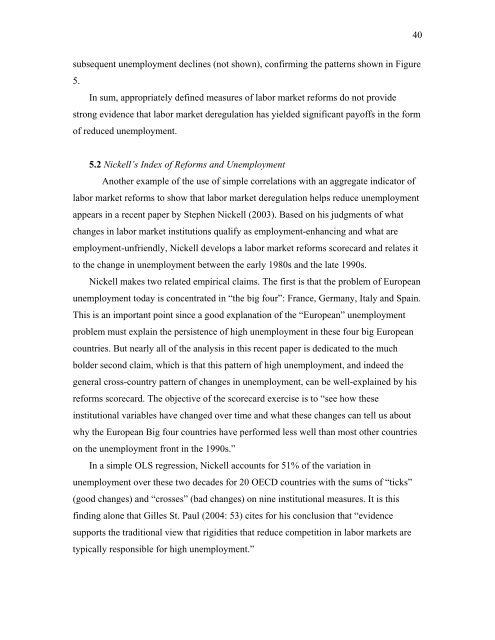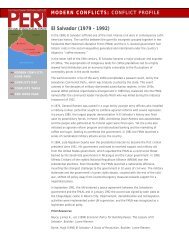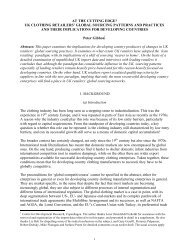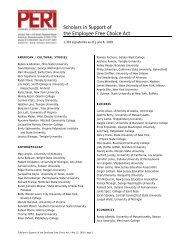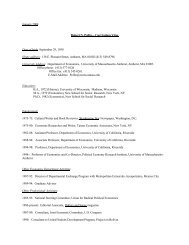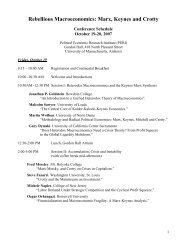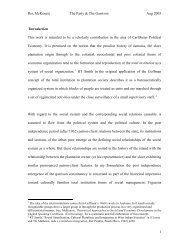Are Labor Market Institutions Really at the Root of Unemployment ...
Are Labor Market Institutions Really at the Root of Unemployment ...
Are Labor Market Institutions Really at the Root of Unemployment ...
Create successful ePaper yourself
Turn your PDF publications into a flip-book with our unique Google optimized e-Paper software.
40<br />
subsequent unemployment declines (not shown), confirming <strong>the</strong> p<strong>at</strong>terns shown in Figure<br />
5.<br />
In sum, appropri<strong>at</strong>ely defined measures <strong>of</strong> labor market reforms do not provide<br />
strong evidence th<strong>at</strong> labor market deregul<strong>at</strong>ion has yielded significant pay<strong>of</strong>fs in <strong>the</strong> form<br />
<strong>of</strong> reduced unemployment.<br />
5.2 Nickell’s Index <strong>of</strong> Reforms and <strong>Unemployment</strong><br />
Ano<strong>the</strong>r example <strong>of</strong> <strong>the</strong> use <strong>of</strong> simple correl<strong>at</strong>ions with an aggreg<strong>at</strong>e indic<strong>at</strong>or <strong>of</strong><br />
labor market reforms to show th<strong>at</strong> labor market deregul<strong>at</strong>ion helps reduce unemployment<br />
appears in a recent paper by Stephen Nickell (2003). Based on his judgments <strong>of</strong> wh<strong>at</strong><br />
changes in labor market institutions qualify as employment-enhancing and wh<strong>at</strong> are<br />
employment-unfriendly, Nickell develops a labor market reforms scorecard and rel<strong>at</strong>es it<br />
to <strong>the</strong> change in unemployment between <strong>the</strong> early 1980s and <strong>the</strong> l<strong>at</strong>e 1990s.<br />
Nickell makes two rel<strong>at</strong>ed empirical claims. The first is th<strong>at</strong> <strong>the</strong> problem <strong>of</strong> European<br />
unemployment today is concentr<strong>at</strong>ed in “<strong>the</strong> big four”: France, Germany, Italy and Spain.<br />
This is an important point since a good explan<strong>at</strong>ion <strong>of</strong> <strong>the</strong> “European” unemployment<br />
problem must explain <strong>the</strong> persistence <strong>of</strong> high unemployment in <strong>the</strong>se four big European<br />
countries. But nearly all <strong>of</strong> <strong>the</strong> analysis in this recent paper is dedic<strong>at</strong>ed to <strong>the</strong> much<br />
bolder second claim, which is th<strong>at</strong> this p<strong>at</strong>tern <strong>of</strong> high unemployment, and indeed <strong>the</strong><br />
general cross-country p<strong>at</strong>tern <strong>of</strong> changes in unemployment, can be well-explained by his<br />
reforms scorecard. The objective <strong>of</strong> <strong>the</strong> scorecard exercise is to “see how <strong>the</strong>se<br />
institutional variables have changed over time and wh<strong>at</strong> <strong>the</strong>se changes can tell us about<br />
why <strong>the</strong> European Big four countries have performed less well than most o<strong>the</strong>r countries<br />
on <strong>the</strong> unemployment front in <strong>the</strong> 1990s.”<br />
In a simple OLS regression, Nickell accounts for 51% <strong>of</strong> <strong>the</strong> vari<strong>at</strong>ion in<br />
unemployment over <strong>the</strong>se two decades for 20 OECD countries with <strong>the</strong> sums <strong>of</strong> “ticks”<br />
(good changes) and “crosses” (bad changes) on nine institutional measures. It is this<br />
finding alone th<strong>at</strong> Gilles St. Paul (2004: 53) cites for his conclusion th<strong>at</strong> “evidence<br />
supports <strong>the</strong> traditional view th<strong>at</strong> rigidities th<strong>at</strong> reduce competition in labor markets are<br />
typically responsible for high unemployment.”


